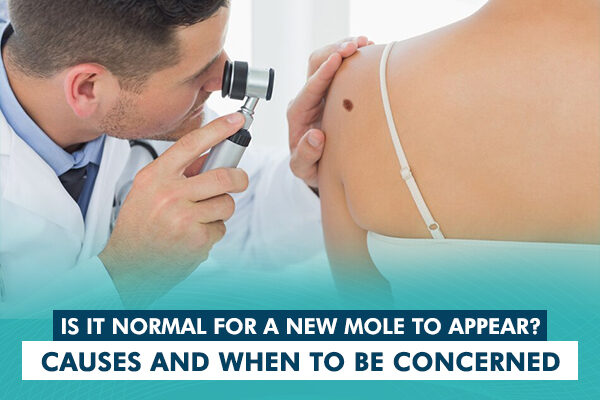
Moles are common occurrences on the skin. They usually develop during childhood and teenage, but it’s not uncommon for new moles to appear between the ages 18-15. While most of the moles are harmless, it’s important to understand the reason behind their occurrence and when to be concerned about changes in their characteristics. Let’s discover more about moles in this blog and find out what to do when they suddenly occur. Read on!
What are the Reasons behind the Appearance of New Moles?
The development of new moles depend upon to 4 major factors, such as:
- Family History of Moles: Genetics play a crucial role in discovering an individual’s vulnerability or chances to develop moles. Hence, If you have a family history of moles or melanoma, you may have more chances to develop new moles.
- Exposure to Sun: Ultraviolet radiation or UV rays from the sun is a major risk factor for the development of new moles. Prolonged exposure to UV rays can trigger the growth of moles and increase the risk of melanoma, which is the most common type of skin cancer.
- Hormonal Changes: Hormonal fluctuations, such as those occurring during puberty, pregnancy, or hormone replacement therapy, can stimulate the appearance of new moles. These changes can alter melanocyte activity, leading to the formation of pigmented lesions.
- Age Factor: While most moles develop during childhood and adolescence, new moles can still appear in adulthood. As the skin ages, cell turnover slows down, making it easier for new moles to form.
When to be Concerned about New Moles?
While many moles are benign, it’s essential to monitor them for any changes that could indicate skin cancer. Here are some warning signs to watch out for:
Asymmetrical Moles: A mole that is asymmetrical, meaning one half is different in shape or size from the other half, could be a cause for concern.
Irregular borders: Moles with irregular, blurred, or jagged borders may indicate melanoma. Healthy moles typically have smooth, well-defined borders.
Color Variation: Moles that keep on switching multiple colors or changes in coloration, like shades of brown, black, blue, or red, should be evaluated by an experienced dermatologist.
Diameter: Moles larger than the size of a pencil eraser (6mm) or those that are rapidly increasing in size should be examined by a medical professional.
Changing Appearance: Any changes in the size, shape, color, or elevation of a mole, along with symptoms such as itching, bleeding, and crusting requires prompt medical attention for further evaluation.
What to do if You Notice Changes in the Moles?
If you observe any concerning changes in your moles, it’s crucial to take action Immediately:-
Schedule a Visit to Dermatologist : Make an appointment with a dermatologist or healthcare provider for a thorough skin examination. They can assess the mole and determine whether further evaluation or treatment is necessary.
Keep Track of Changes: Take note of any changes in your moles, including size, shape, color, and symptoms. You can also keep taking photographs of your newly appeared moles. It can be helpful for tracking changes over time.
Stay Sun Safe: Protect your skin from the sun’s harmful Ultraviolet rays by wearing sunscreen, protective clothing, and seeking shade, especially during peak day hours.
Avoid Using Tanning Beds: Avoid artificial UV radiation from tanning beds, as it can increase your risk of developing skin cancer and promote the formation of new moles.
Try Laser Mole Removal Treatment at SkinQure
Laser Mole Removal procedure at SkinQure is tailored specifically to individual needs. Our experienced dermatologist Dr. B.L Jangid & skilled therapists prioritize your comfort and safety above everything else. With the help of cutting edge laser technology, we treat each mole with precision, minimal discomfort and maximum effectiveness. We make sure that our clients get the natural-looking results they desire and get satisfied with the final outcome. Over all, SkinQure makes it a point to support you at every step in your journey to mole-free skin.
Conclusion
Usually, the appearance of new moles is considered normal. However, it’s important to remain alert and monitor them for any changes that can indicate skin cancer.
Understanding the causes behind new mole formation and knowing when to visit a skin specialist are important steps in maintaining skin health. By practicing sun protection and monitoring your skin regularly, you can reduce your risk of skin cancer and ensure early detection of your condition.
If you have any concerns about your moles or you are looking for laser mole removal treatment, consult our senior dermatologist, Dr. Jangid, for further evaluation and your peace of mind.
Do you want to book a consultation? Call +91-9266555500.
